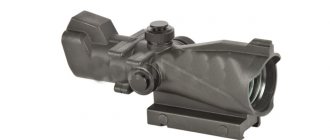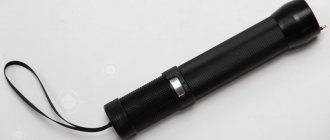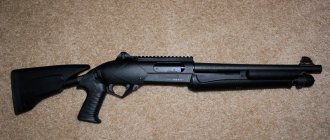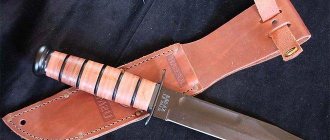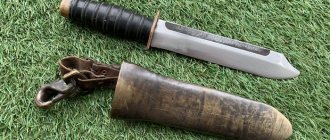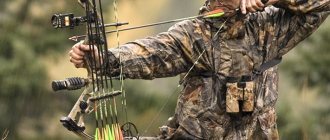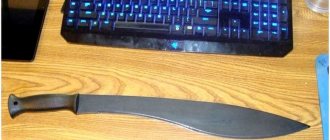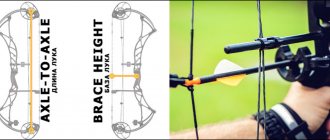Characteristics of survival knives
If necessary, this tool can easily replace a saw or an ax and will help in extreme situations. The harder the steel from which it is made, the less often it needs to be sharpened. The ideal hardness is between 55 and 58 units.
The length of the blade also plays an important role in ease of use. It is better to choose a knife blade with a length of about 80-150 mm. Manufacturers are constantly trying to increase the functionality of such products and do not position them as edged weapons.
The most convenient blade length for a survival knife is 80-150 mm
Scope of use
Survival knives are sometimes called multitools, which literally translates to multi-tool. If at first they were used only by the military, now they are used everywhere. A good multitool is made of high-strength steel and has many additional accessories built into the handle.
The design of multitools is increasingly being improved, complemented by various devices hidden in massive handles. This tool is indispensable in extreme conditions, in the forest and on hiking trips.
Multitool is a convenient device, the handle of which contains additional devices.
You should not save money when purchasing such a device, because if necessary, it may well save the life of its owner.
What are they made from?
An excellent, reliable blade is made of high-carbon steel with the addition of vanadium or chromium, has a long-term sharpening and a reinforced tip. The blade remains sharp for a long time, is not afraid of moisture, does not rust or break.
It is recommended to choose models with a high-quality steel blade
The handle inside can be hollow, and its shape allows it to accommodate an emergency emergency supply (ESP) for all occasions.
NAZ includes:
- wax matches;
- fishing line and hook for fishing;
- sewing and medical needles and nylon threads;
- tablets for water purification, potassium permanganate;
- pin;
- antibiotics;
- patch;
- thin blade;
- a piece of sandpaper for sharpening the blade;
- magnifying glass
Useful tools included in the NAZ
Some models include a compass, which significantly increases the chances of survival in a dangerous situation. The only condition is that the blade and handle must be made of non-magnetic material, otherwise such a compass will not be of much use.
Purpose Determines Shape
Most experts note that such a knife with a sharp blade is the best tool for survival. A person who finds himself in an extreme situation will be able to survive for some time in the wild forest using this device. With a wide blade you can chop wood or dig a hole, and a massive, strong butt will allow you to easily hammer a nail or hit an enemy.
A knife for survival in extreme conditions should be equipped with a fixed blade and a wide blade. When going to familiar places over short distances, it is better to take a pocket folding knife, but this option is not suitable for an experienced survivalist.
Peculiarities
The main feature of the tool is its versatility. So, with its help you can:
- make a bonfire;
- get food;
- carve a path in dense thickets;
- protect yourself from a sudden attack;
- cut and sew thick fabric or animal skin.
Using a functional tool, you can perform several actions.
If a compass is built into the handle, the knife will help you navigate the terrain and find your way.
If necessary, it is capable of acting as a military weapon for self-defense.
Rating of the best knives
A man might be interested in the top survival knives. It presents interesting models that have already earned the trust of hunters and extreme hikers.
Jungle King
For those who like to travel, the knife will be indispensable, as it has a built-in compass.
This model is produced by the Aitor brand. The blade of the tool is made of a practical alloy based on chromium and molybdenum. Its hardness is 59 units. The length of the blade is limited to 13.5 cm. There is a NAZ in the handle of the knife. It also contains a compass, which will help the traveler not to get lost on the way.
There is a twine on the sheath. The owner of the knife can use it at his own discretion.
NV-1-01
A variant of a domestic knife, which has certain similarities with the Jungle King II model. The length of the tool blade is 16 cm. 8HF grade steel is used in production. The knife handle is also steel. Inside it are placed the items that are included in the NAZ kit.
The knife is equipped with a built-in compass. Its sheath is divided into equal cavities. The first contains a saw and a skinner knife, and the second has a cord wound around it.
Functions of survival knives
Ideally, a survival multitool is not just a strong knife with a sharp blade, but also a tool that allows you to easily cope with various tasks. Of course, a lot depends on experience and skill in its application. However, the characteristics of such a knife and the material from which it is made play an important role.
Shelter construction
Using a knife, you can dig a small hole, chop firewood and cut spruce legs, and sharpen pegs for an impromptu hut. It is enough to dig sharp stakes into the ground, tie the tops and cover the finished shelter with branches.
The knife can be used to create temporary shelters
Foraging for food
A fishing line with a hook in the handle will allow you to catch fish, and matches or a bag of flint will help you make a fire. A steel blade is indispensable during hunting, skinning and butchering game. You can use the butt to crack nuts, and use the blade to dig up edible roots and cut off thin branches to make traps.
Self defense and self defense
Considering that the knife is excellent for hunting, it can be used as a weapon in the fight against the enemy. Due to its design features, it is suitable as a melee weapon.
A multitool can be an effective means of self-defense
Making tools and weapons
The sharp blade of the blade is indispensable in the manufacture of a club, harpoon, spear, and oar. Moreover, not only wood is used as a material, but also bone, a fragile metal.
Starting a fire
You can chop firewood and prepare wood chips for kindling. Matches or flint in the handle will help start the fire.
Compact multifunctional knife has a number of tools for starting a fire and preparing firewood
Location orientation
If the NAZ includes a magnetic compass, then you can easily find your way in an unfamiliar place. If there is no such function, you will have to navigate using the solar vector. And again, a tactical survivalist knife will come to the rescue.
First aid
In most multitools, the handle contains medical needles and threads, tablets, bactericidal patches and magenta. If something happens, you can sew up and disinfect the wound yourself, apply and secure a splint.
The NAZ, located in the handle of the knife, may include basic medical supplies
What can you do with a survival knife?
A “survival knife” is exactly what can help you survive. It's a tool with literally hundreds of survival-related features. Below is a short list:
- Cutting/slicing.
- Kopka.
- Split.
- Self-defense.
- First aid.
- Cooking food.
- Making a shelter.
- Kindling the fire.
- Hunting weapon.
- Use as a hammer.
- Use as a screwdriver.
Product classification
There are different types of knives, but when choosing, you need to consider the area of its application. If you have an extreme hike in dangerous unfamiliar places, you shouldn’t skimp on buying such a tool. In this case, it is better to choose a versatile and reliable survival knife. They are classified according to several main positions.
According to blade material
The most common blade material is carbon steel. But in its pure form it is susceptible to corrosion, does not tolerate moisture well and periodically requires sharpening.
An alternative would be steel with an admixture of vanadium, chromium or coated with zirconium dioxide. An ideal blade should be resistant to high humidity, chemicals and dirt.
The knife blade, made of stainless steel, easily withstands moisture and maintains an edge.
As for the hardness of the metal, it is better to choose medium, because it is difficult to sharpen a blade that is too hard. The thickness of the blade also plays an important role, which ideally varies from 3.8 to 6.4 mm. Too thin can break, and thick is inconvenient to use.
By handle type
Some models come with a solid handle, while others have a hollow handle that houses the NAZ. In the latter case, the strength of the knife suffers, because the hollow handle breaks faster and holds a blow less well. Utility knives are often made with a durable handle, and the NAZ is stored in a sheath.
The handle is often made of natural bone, wood, metal or plastic. Many people choose wood, which, although it absorbs moisture, is suitable for use in hot or cold weather.
Wooden handles are more comfortable to hold, they are lighter and cheaper, but are susceptible to moisture
Bone is considered the most reliable material, but such a product is too expensive.
By sharpening method
There are two types of sharpening: regular and serrated, and the latter lasts much longer and allows you to cut any hard and layered materials. Expert opinion boils down to the fact that survival knives should be versatile and easy to use. This means that smooth sharpening is more suitable for them.
To maintain the sharpness of the knife, it is recommended to use a smooth sharpening
By shank type
With the help of a shank, the blade is attached directly to the handle, while for folding knives the fastening passes through the axis. When it comes to survival knives, they have full tangs and partial tangs.
In the first case, the shank is a continuation of the blade and completely fills the handle. In the second, it is half hidden, and the remaining part of the hollow handle is occupied by NAZ. If the first option is the strongest and most reliable, then the second is less durable.
Shank - a metal part completely or almost completely hidden in the handle of a knife
Blade shape
Each manufacturer tries to improve their product, so the blade can be of absolutely any shape and length. There is no definite advice on choosing here, because not a single blade will meet all requirements.
The blade with a straight spine is considered the most popular among experienced extreme sports enthusiasts: it is suitable for any needs, but is not used as a self-defense weapon.
The blade with a straight spine copes well with specific tasks
Which knives are not suitable for survival purposes?
You cannot trust the advice of experienced marketers and salespeople. They are not always aware of the likelihood of a dangerous situation occurring on the road, so they impose stereotypes. It is important to rely on personal feelings.
Don't focus on the size of the knife. A large knife is not always convenient when traveling. It is bulky and heavy, and it is almost impossible to perform small work that requires painstakingness.
The presence of a second cutting edge is optional. In inexperienced hands such weapons are quite dangerous. It performs not cutting, but piercing movements.
At the same time, the tip of most models is thin and is a weak point. A hollow handle is not a big necessity. The advertisement assures the buyer of the convenience of having NAZ at hand.
However, if a tourist loses a knife, then all survival equipment will also be lost. It's better to put them in a nearby pocket. In addition, the attachment point to the handle is considered weak. Finding yourself in an extreme situation with a broken knife handle is not the most pleasant option.
Rating of high-quality and inexpensive survival knives
Purchasing such an item can cause a serious blow to your budget. Although most are made in China, there are several options that combine affordability with high quality.
Gerber spine
A very simple and easy-to-use specimen, with a full shank and a rubberized handle. Although it looks unpresentable in appearance, it is made of durable steel, sharpens well, and has a well-fixed blade.
Pros:
- high quality steel;
- rubberized handle;
- practicality and functionality;
- durability.
The Gerber spine hunting knife is a convenient and reliable tool for survival in extreme conditions
. There are no downsides to the gerber spine, and it costs only 2,800 rubles, which is quite a bit for such a high-quality knife.
Nightnale
The product is Chinese, but extremely popular among experienced tourists and survivalists. It is useful in extreme conditions, although it weighs a little more than 200 g. It has a special fastening for a safety rope, a sharp blade 115 mm long and an ABS plastic handle.
Advantages:
- strength;
- practicality;
- ease of use;
- light weight;
- reliability.
Nightnale is a durable knife made of stainless steel.
You can buy such a blade for 3000-3500 rubles, and no shortcomings have been found in it during operation.
Ganzo g 8012
An equally interesting high-quality budget model produced in China. The blade is 115 mm long, tightly fixed in an ABS plastic handle. It also contains a diamond sharpener, a cutter and a hanging belt. Blade with straight sharpening, made of matte durable steel.
Pros:
- reliability;
- functionality;
- quality;
- durability;
- practicality.
Ganzo g 8012 is a budget model with a fixed blade.
In addition, the metal of the product is durable and does not glare. The price is reasonable - no more than 3,600 rubles.
Victorinox hunter pro 0 9410
This folding Swiss survival knife is perfect for outdoor enthusiasts. It has a wide blade and a comfortable handle made of non-slip plastic. It is distinguished by high build quality and presentable appearance, simple and easy to use.
The manufacturer gives a lifetime warranty on the product, which indicates its reliability.
Among the shortcomings, tourists note the lack of additional tools in the set. The average cost is about 4,500 rubles.
The hunting knife Victorinox hunter pro 0 9410 is characterized by high corrosion resistance and ductility
Buck 656 pursuit
An excellent, durable, high-quality blade made of durable steel is fixed in a handle with rubber pads. Specially treated nylon is used for production, and a sheath made of durable polyester reliably protects the blade.
Advantages:
- durability;
- Ease of use;
- quality;
- strength.
Buck 656 pursuit stands out among many hunting knives due to its craftsmanship and high-quality materials.
No shortcomings were found, and the price will be about 4,450 rubles.
Courier aus 8 tw
A Russian-made product, specially manufactured for the Russian Federation Courier Service. The durable blade, 152 mm long, is resistant to any damage, and a special serial sharpening allows you to cut metal with ease. It has a polyamide handle with finger grooves and longitudinal grooves.
Pros:
- titanium coated steel;
- versatility;
- reliability;
- functionality;
- practicality;
- durability.
The blade of the Feldjeger aus 8 tw knife is highly reliable, and the handle is resistant to mechanical loads
. In this segment, this is one of the best knives, but it will also cost more - about 4900 rubles.
Rating of knife steels
For convenience, in the TOP steels and alloys for the manufacture of fixed-type knife blades, they are presented in order of increasing characteristics and prices, respectively.
9ХС
High carbon steel is present at the bottom of the rating due to the fact that it is a sales leader. Knives of the budget category with a decent cut and an edge that doesn’t dull for a long time. 9ХС steel is very difficult to forge; if the temperature conditions are violated, the edge will crack. But, after proper forging, the edge is able to withstand light impact loads. For example, you can use a knife to chop branches for a fire.
Inexpensive high-speed steel was originally developed for the mass production of drills. This carbon became a knife material much later.
95Х18
Domestic forged stainless steel, completely maintenance-free, usually with a glossy, shiny polished mirror surface. Steel belongs to the budget category and is available to a wide range of consumers. It cuts somewhat worse and dulls much faster compared to high-carbon steels. It is not afraid of shock loads, but has low fracture strength.
Steel 95X18 can be hardened to a cutting edge strength of 58 HRC. The first sharpening is carried out at the factory, after which the knife can be easily straightened and sharpened at home without special tools. Food acids and high temperatures in household ovens cannot corrode stainless steel.
Blades made of steel 95X18 are used in fishing, tourist, chef, cutting, fillet, souvenir, and gift knives. Hunters with licenses for large game - elk, wild boar - rarely use it. Aggressive cutting is impossible in principle here. Professionals believe that stainless steel “irones” and does not cut. The sharpening is not enough to cut an adult elk. The blade will have to be sharpened during the process in the field, which is uncomfortable, for example, in winter.
Friends!Subscribe to ouryoutube channelWaiting for you! |
N690
Another steel from the manufacturer Bohler (Austria, Germany), completely stainless, under no circumstances. The hardness of N690 depends on the heat treatment cycle:
- when quenching in oil after heating at +1030°C followed by tempering twice for an hour at +190°C, the hardness is HRC 59 units;
- by increasing the hardening temperature to +1080°C with exactly the same tempering conditions, the hardness reaches HRC 61 units.
Compared to X12MF, this steel dulls a little faster, but sharpens faster and easier, and does not require maintenance. Martensitic stainless steel has a high carbon content to ensure aggressive cutting properties - hardness, long-term sharpening, and sharpness. To prevent it from rusting, alloying elements are introduced into the steel. They also provide elasticity, plasticity, and viscosity.
K110
If the previous alloy is positioned by knife workshops “for the chopper,” then the Bohler K110 is intended exclusively for cutting, dissecting, planing and piercing. The material absolutely cannot withstand shock loads, breaking out, rotation, or fracture stress. With the same average purchase price as N690, K110 steel is much cheaper to process.
Accordingly, the knives are cheap, the blades do not rust at all with a high chromium content. They are used in all areas of life and extreme hobbies, if they are not subjected to the above categories of loads. In field conditions, the cutting edge of a blade that has become dull when cutting a deer can be corrected on a nearby stone, a gun barrel, or a metal flask.
Damascus
The next hardest knife material is Damascus steel with an HRC of 61 units. In its category, this is the only material in which the characteristics are determined not by chemical, but by mechanical methods. Roughly speaking, in steels and alloys, iron, carbon and alloying additives enter into a chemical reaction at the time of melting and during subsequent heat treatment. That is, at the molecular level.
In Damascus, strips or wires of low and high carbon steels and/or nickel (tessellated Damascus) are welded to each other, twisted or bent repeatedly at high temperatures. In this case, the metals do not melt, but they are soldered together to a homogeneous structure.
Thus, Damascus can be considered as a mixture of pieces of hard high-carbon steel in a ductile medium of low-carbon steel. Carbon sharpens, has an aggressive cut, and does not dull for a long time. Impact loads during cutting and bending forces applied to the blade are compensated by the ductility of low-carbon steel around the grains of high-carbon steel.
The disadvantages of Damascus are low corrosion resistance and the need to maintain the blade, respectively. Damascus bags are welded and forged by hand, which increases the production cost of each product. In addition, expensive metals or a large number of different steels with different properties can be added to patterned steel.
Therefore, Damascus can be cheap and expensive. Some of its types are used exclusively for “shelf” knives, which are never used for their intended purpose. They are used to replenish collections, give knives as gifts or buy them as souvenirs, and decorate interiors with copies of bladed weapons. However, they all maintain an aggressive cut and a long-lasting edge retention.
X12MF
The most popular structural material for blades on the Russian knife market is, undoubtedly, X12MF steel. In the middle price category, it has a perfectly balanced ratio of quality and production costs. The HRC hardness index of 62 units is combined here with a high content of alloying elements. However, the steel is conditionally stainless and uses a standard operating algorithm:
- you can cut and chop any food;
- After use, the blade must be rinsed;
- After each use, the knife is wiped dry;
- Before long-term storage, the steel is lubricated with any oil available in the house.
Conventionally, stainless steel X12MF is ideal for hunters (aggressive cutting of skin and meat) and tourists (planing, chopping, cutting, piercing, dissecting materials). For fishermen and cooks, this is not the best option due to the high moisture content, food acids, and high-temperature environments.
Bohler K340
K-340 steel is produced by the Austrian-Danish concern Bohler, and among specialists it is called cast Damascus. The blade can be used to chop off the horn of a cow, open a tin can, and the K 340 shows good results in the rope test. The hardness is comparable to the previous version X12MF - 62 Rockwell units. However, there is less carbon here, and the hardness is provided by alloying elements.
Accordingly, the corrosion resistance of K340 is higher; the blade does not split if accidentally dropped on stone or iron. The standard for this grade of steel is the StoneWash finish - etching to a matte gray color in acid, then treated with a jet of emulsion with an abrasive (sandblasting or shot blasting).
The material is, in principle, not fancy, reliable for fishing, hiking, hunting and in the kitchen. With minimal maintenance, the knife will last a very long time.
ХВ5
Both manufacturers and consumers often call XB5 steel “diamond” due to its hardness HRC of 65 units. For everyday needs and extreme hobbies this is more than enough. This is exactly the case when the user sacrifices comfort for the sake of bare functionality.
The diamond will not become dull when cutting two elk carcasses; it cuts aggressively, but you will have to take care of the knife more carefully. Because metal rusts in water, in aggressive environments, when chopping vegetables, gutting fish, and even from human sweat. If you hold a collectible knife with a blade made of XB5 in your hands and put it in a case without wiping the blade, dark spots will appear on it, which are much more difficult to remove than to carry out preventive measures before.
The cutting edge becomes especially fragile in the cold; dropping it on stones in winter is not recommended. Bones are not cut with an XB5 diamond, and cans are not opened. But with such a knife you can perform tricks with cutting hair on the arm, cutting paper and scarves that fall to the edge under its own weight.
M390 and Elmax
Elmax and M390 powder steels produced by the international Austro-Swedish company Bohler Uddeholm have identical properties. Elmax steel with a hardness of HRC 64 units does not rust in high-temperature and aggressive environments. Strength combined with high toughness, that is, the properties of Damascus provide a strong cut, long retention of sharpening, resistance to impact, bending, torsion and breaking loads.
Alloy M390 is an improved version of Elmax with 1.9% carbon instead of 1.7%, chromium content 20% instead of 18%. A non-specialist will not notice the difference between the ancestor of powder steels Elmax and the modified version M390, whether on meat or vegetables.
Such blades are expensive, but they do not require maintenance, hold an edge for a long time, and are sharpened once a month if properly stored. These are good in the kitchen, camping, fishing, hunting, mushroom picking, preparing brooms, that is, “for all occasions.”
Bulat
The production of Bulat consumes a large amount of energy, manual labor, and material assets. For example, to smelt 2 - 3 knife strips, one medium-sized crucible is consumed, which is destroyed after smelting due to loss of working properties.
The steel is high-carbon, alloyed, but unfortunately does not have anti-corrosion properties. Therefore, care is necessary, hardness and ductility are high. Bulat steel is in demand by all categories of users.
P18
Domestic high-speed steel R-18 was created for the manufacture of turning, drilling, and milling tools. That is, after sharpening the edge, it can easily cut less durable steels and any other structural materials. Therefore, a priori, with everyday tasks - cutting up a wild boar, picking up a bear on a hunt, filleting fish on the river, sharpening tent pegs on a hike, chopping branches for a fire in the country, slicing sausage at a picnic, meat and vegetables in the kitchen, it copes 100%.
The hardness of the metal is 65 units on the Rockwell scale. Therefore, the slang, highly specialized name P18 “diamond” steel does not correspond to reality. On the Rockwell scale, this mineral is assigned a value of 100 units. Simply, at the time of its inception, steel was considered the strongest of the existing cast modifications.
It should be understood that the characteristics of the blade depend on the steel grade by only 50%. The rest is decided by the geometry of the blade - the sharpening angle, the type of bevel (Scandi, straight wedge, Convex), the presence of leads, the shape of the cutting edge (smooth, teeth, serrated, wave).
Therefore, with some P18 diamond knives you can actually open cans, scratch, cut glass, HRC 61 units, which is 3 units lower than that of the material in question, and perform other tricks while fishing, hunting, or camping around a fire.
Knives made from quick-cut P18 are used mainly by professionals and wealthy lovers of extreme types of hobbies. Hobbyists and users of budget categories often forge blades from reamer, taps and drills, dies and countersinks, and other tools made from R-18 diamond.
Laminate
Unlike construction finishing material with the same name, knife steel of this type is in strong demand in the professional environment. Laminated steel is the third variety of Damascus and Bulat to solve the same problem - to combine the properties of the highest hardness, toughness, strength and ductility in one material or, in extreme cases, a product.
The way to solve the problem here is different, no less original. The core is made from a strip of high-carbon steel with a maximum carbon content, for example, U-12. On the sides the core is lined with two layers of Bulat, Damascus, stainless steel, corrosion-resistant or any other steel with special properties.
When sharpening, the side layers are ground down to zero, and the core is sharpened with an abrasive tool. Rust can only occur on the cutting edge; the butt, butt, heel and slopes are protected from corrosion through the use of alloys with appropriate properties.
Covers with a hardness of HRC 35 units do not allow the core HRC 62 - 6 units to break under torsional, breaking loads. They may have high decorative qualities, for example, the Damascus pattern “Mosaic”, “Cobweb”, “Thunderstorm”, “Rhombus”, “Runes”.
The blade is suitable for defense, kitchen, picking up animals, cutting fish, setting up a tourist camp, collecting, interior decoration, for example, in a fireplace room or a hunting lodge.
PGK
PGK steel is a successful development of the German family plant Lohmann. It successfully competes with more expensive and famous alloys CPM 3V and CTS-PD1 from US institutes. When tested - 10 blows on a cattle tibia, dry bamboo and elk horn - the 40° cutting edge remains intact and does not change the geometry.
When the sharpening angle is reduced to 15° on each side, the edge begins to crumble and bend, like a scythe when punched with cold work. Thus, during aggressive aggressive cutting of meat and animal skins, German PGK steel has high toughness, ductility, and elasticity.
Accordingly, PGK stainless steel is suitable for all types of knives - lockjaw, fishing, mushroom picking, hunting, harvesting herbs and brooms, cutting food, sharpening stakes, but with the correct choice of blade geometry.
S390
Steel S 390 is a Russian powder quick cutter with improved characteristics. Tool steel has virtually no defects or imperfections and has a homogeneous structure. After heat treatment, the hardness of the cutting edge is HRC 69 units. In the catalogs of most knife shops, this is the hardest construction material.
The maximum that can happen to this conditionally stainless steel is the appearance of dark spots that spoil the design of the blade. Therefore, minimal care for expensive S390 knives is still necessary. With the correct sharpening angle of the cutting edge, you can show tricks to the sharpness of the blade - it will cut silk scarves and bird feathers on the fly.
If there is a butt, the blade can scratch glass and cut bottles, and perform tricks on the strength and hardness of the knife. The price of such blades is the highest in their category. A knife from S390 costs as much as a Damascus saber three times the size.
Friends!Subscribe to ouryoutube channel |
Rating of popular models of survival knives in the budget segment
Everyone can choose a product to their taste from budget models.
Basurmanin
This professional instrument, produced in the Russian Federation under the name “Basurmanin”, includes a whole set of necessary items.
It includes:
- matches;
- threads;
- needles and pins;
- water filtration tablets;
- fishing line;
- sulfur paper.
Basurmanin is an army survival knife, which is particularly durable and reliable.
A knife with a durable blued steel blade, 160 mm long and 35 mm thick. Inside the steel handle there are two compartments, one of which contains a durable cable, and the other contains a stiletto and saw.
This model is distinguished by quality, reliability, durability and practicality. An additional advantage is the complete set and ease of use. There are no downsides to this product, and the price starts from 5,000 rubles.
Camillus trekus
The Chinese folding knife is quite small in size, but weighs almost 350 g. The blade is made of hard steel, and the handle is made of fiberglass. The knife opens and folds quickly, remaining high quality, durable and strong. The cost reaches 5,570 rubles, which is quite acceptable for such a product.
Camillus trekus – multifunctional survival knife
Mora bushcraft survival
It is produced in Sweden and is deservedly popular among fishermen, hunters and tourists. It has a fixed blade made of durable steel with a length of 109 mm and a rubberized plastic handle. The manufacturer provides a warranty for the entire service life, which confirms the high quality of the product. The kit includes a flint, a diamond sharpener, and removable clips. You can buy a functional, reliable, durable tool for RUB 5,720.
The Mora bushcraft survival knife provides a good cut and has excellent cutting properties
Esee Ashley game knife micarta
It looks simple on the outside, but is highly durable and versatile. The comfortable extended handle is made of micarta and leather, and the blade is 117 mm long and made of hard steel. This high-quality American blade costs about 6,660 rubles, but it justifies its price by 200%.
The ideal hunting knife with which you can take on any animal.
Esee ashley game knife micarta is a convenient knife designed for hunting use
Survivalist zd 2 tw
The product of the Russian manufacturer not only looks impressive, but also impresses with its functionality. The blade is large (193 mm), and it weighs 360 g. The blade is made of high-strength hard steel with titanium coating and is indispensable in extreme conditions.
The aluminum handle contains the NAZ, which includes:
- a pair of blades;
- matches;
- pin;
- patch;
- needle and thread;
- wire;
- fishing line;
- sinkers.
NAZ in the handle of the Survivalist zd 2 tw knife
The knife is wear-resistant, not afraid of corrosion, and comfortable to use. The only drawback is the high price, which is 7,500 rubles.
We knife with vaquita
An excellent specimen, made using high-strength steel that is resistant to external influences. It has an unusual 8 cm long blade, a full tang and a comfortable handle with a neck hanger. A beautiful and practical knife sells for 7,990 rubles.
The We knife co vaquita knife has high quality, reliability, and an extraordinary design
Large selection of knives
Use the above criteria as a guide for selecting a potential survival knife. Only you can determine the features you are and are not willing to compromise on. Beyond that, almost everything else is down to personal taste.
There are many survival knives on the market that include these survival features but are completely different from each other. There are countless design options that depend on personal preference and have little impact on functionality. Some of these features include:
- Blade steel (carbon or stainless – different options with different results).
- Handle material (rubber, bone, wood, etc.).
- Color or finish.
- Holes for lanyard.
- Serrated or toothless blade.
- Sheath design and style.
- Knife designer, manufacturer, brand.
- Blade style.
- With or without finger guards.
- Blood groove.
Which company is better to buy a premium survival knife?
Those who are not afraid of high prices should pay attention to expensive premium knives.
They can be used in an unusual situation or presented as a gift for real men who love extreme sports.
Esee 4p
Functional universal blade of optimal size with a fixed blade made of high carbon steel. The durable micarta handle and polymer sheath make it even more attractive to the buyer.
Esee 4 p is a great survival hunting knife
Advantages:
- high strength;
- quality;
- quality factor;
- functionality.
There are simply no disadvantages to this model, and the cost will be 10,600 rubles.
Rershaw launch 1
A very lightweight and convenient folding tool with a durable, hard blade. Its light weight and size allow you to take it with you in any situation and attach it to your pants belt using a strong clip. Indispensable for avid fishermen and hunters, comfortable and functional when using, durable.
Rershaw launch 1 – lightweight knife with fully automatic blade opening
The automatic blade and sleek design complete the list of advantages. The only drawback noted is that the aluminum handle is not the most durable. The price of the product is 11,550 rubles.
Tops bull trout
A small but multifunctional knife will be a welcome gift for an experienced fishing enthusiast. The blade with a full tang, 7 cm long, is made of high-strength metal and remains sharp for a long time without sharpening.
The comfortable micarta handle is equipped with a special groove for fingers, and the stylish leather sheath will protect the blade from external influences. The average price tag for a product starts from 11,800 rubles and above.
The Tops bull trout knife has a durable blade that holds an edge well and requires minimal maintenance
Bastinelli creations sin wrapped
A model with an original and rather aggressive design, made of Kydex, with a steel blade almost 9 cm long. The blade has grooves and two cutting surfaces at once. This practical and durable knife will last a long time and is ideal for those who love active tourism. The cost of the product is quite high and amounts to a little more than 13,300 rubles.
The Bastinelli creations sin wrapped knife is functional and practical
Ka bar becker kephart
The product is based on the drawings of the famous traveler and writer Horace Kephart. It was he who, at the beginning of the last century, wrote and published a unique book, which became a practical guide for American extreme tourists.
A characteristic feature of the knife is a durable steel blade in the shape of a spear and a wooden handle. Thanks to its high functionality and practicality, it is suitable for use in any situation. The issue price is about 14,000 rubles, which is certainly a lot.
Ka bar becker kephart knife is great for survival in extreme conditions
Spanish King of the Jungle
One of the most popular models among those who like to tickle their nerves on a dangerous journey. In addition to the high-strength blade, made of an alloy of steel with vanadium, chromium and molybdenum, the product is equipped with a compass and NAZ.
It includes:
- gunpowder and flint;
- antibiotics;
- tweezers;
- tourniquet;
- patch;
- antiseptics;
- stiletto screwdriver;
- insect repellent;
- strong cable.
The Spanish King of the Jungle is the ideal knife for a true survivalist.
The manufacturer produces knives with three different blades to choose from. All of them have an anti-corrosion coating and are resistant to damage. Such pleasure is not cheap - 18,800 rubles.
Cold steel 3 v srk
The name of the model literally translates as “knife for rescue and survival,” which is completely true. The durable steel blade can easily withstand any load and operating conditions. It is characterized by increased wear resistance and versatility.
The shape of the blade and handle externally resembles the legendary weapon of the American Navy SEALs.
Such a knife costs about 19,000 rubles, and you can purchase it in specialized stores.
The Cold steel 3 v srk knife is able to withstand any load and maintain functionality under any conditions
Spyderco respect
The most expensive copy from the premium segment, but it fully justifies its price. A powerful 20-centimeter blade is suitable for chopping and cutting hard materials. The G 10 plastic handle and high-strength steel blade are packaged in a handmade leather sheath.
A convenient, multifunctional knife will become the first assistant of an extreme tourist, hunter or climber. You can buy it for 29,000 rubles.
Spyderco respect knife is great for hunting and survival in harsh conditions
Tips for choosing the best camping knife for survival in extreme conditions
A folding knife is more convenient to use, has a small size and a spacious handle. However, this option is not suitable for everyone, because in an emergency it is of little use.
Flaws:
- Due to the folding design, such a knife is more likely to break even under light loads.
- It has a small blade and a narrow spine.
- Difficulties arise when an instant reaction is required, and it is unlikely that it will be possible to open it so quickly.
In extreme situations, opening a folding knife is much more difficult than a knife with a fixed blade.
This option is more suitable for a traveler or tourist, but for extreme hikes, choose a reliable model with a fixed blade.
Blade shape
A knife is one of the most important items on any trip, and you need to choose it carefully, taking into account all the nuances.
The blade shape is:
- with straight butt;
- with a rising (falling) butt line;
- spear-shaped;
- with a concave blade;
- American tanto.
Basic blade shapes
Survival knives are often chosen with a universal spear-shaped blade. They are easy to use and are used by hunters and fishermen.
Shank
A professional survivalist tool can have a full or partial shank. There are models in which the shank is half hidden in the handle, and the remaining part is occupied by the NAZ.
However, specimens with a full shank that runs through the entire handle have increased reliability and strength.
A knife with a full tang is considered more durable and reliable.
These knives are designed for use in extreme field conditions; they are unlikely to break and will last much longer than others.
Steel
When choosing a tool, it is important to pay attention to the quality of the steel from which the blade is made. Ideally, it should be carbon or stainless steel. Pure high-carbon steel is susceptible to corrosion, so chromium or molybdenum impurities are often added to it. Stainless steel is not afraid of moisture, but is less durable.
A knife made of stainless or carbon steel will last longer
A blade made from steel that is too hard stays sharp longer but breaks faster. Extreme survival knives have a hardness of 54-58 Rockwell. This steel is much stronger and more durable and can withstand heavy loads better.
Materials for creating the handle
The handle is often made of steel or plastic, but can also be made of wood or rubberized. Steel is better for the handle, but it should be of medium hardness. In this case, the product will have a sufficient margin of safety. The shape of the handle is also important, as it determines the ease of use of the knife.
The knife handle is made of wood, plastic, rubber or steel
Additional options
Almost all good knives have some features and secrets. Some have a fully equipped NAZ, while others have a sharpener and flint inside the handle. Sometimes the manufacturer builds a lighter into the knife, although it is not a mandatory attribute of a survivalist’s kit.
The best knife for survival. Part 2: Top 10 fixed knives
Top Ten Fixed Blade Knives
A good knife is an essential tool for survival. With its help, you can build a shelter, chop wood, open a jar, skin prey, and so on.
When choosing a knife you need to be guided by the following criteria:
1. The steel from which the blade is made
Don't expect that a $10 Chinese knife won't let you down in difficult times. These knives use 400 series steel, which is easy to sharpen but breaks easily, which can lead to injury.
2. The blade must be single-sided
The double-sided blade looks cool, but this negatively affects its strength and practicality: you can’t prepare firewood with it and you can’t hold it by the butt. And in general, a survival knife is more of a tool than a weapon.
The blade should have a drop point and be thick enough. A knife with a curved blade is good for skinning and delicate work. Avoid tanto blades: they are thicker and therefore harder, but cutting something with such a knife is very difficult.
3. Overhead mounting only, the blade should cover the entire length of the knife
Judge for yourself which is stronger: a single beam of steel, or two beams fastened in the middle? Such a knife will not break or bend when you need to use it as a lever.
4. Plain or serrated?
If you don't have to fight with knives every day, then you don't need a cleaver with a huge handle and chainsaw jagged edges. Serrated sharpening is not as practical as plain sharpening, and it has no obvious advantages. If you cannot do without teeth, choose a knife with a partial serrated sharpening.
5. Pay attention to the cross-section of the blade
The flat section is the most common and most practical. A blade with such a cross-section can be easily sharpened in the field.
6. Size matters
A knife that is too large will be difficult to handle, and a knife that is too small will not cope with heavy work. The optimal knife length is 27-28 cm.
7. The handle plays an important role
The shape, feel and material of the handle are just as important as the steel from which the blade is made. Kraton, Micarta, G10, glass reinforced polyamide, dense wood or rubber are excellent handle materials.
If the knife is difficult to hold in your hand, then in a stressful situation you can get hurt or let it slip out of your hands. There are handles with a blunt end, which are suitable for breaking something, or with a hole for a lanyard. But don't buy a knife with a compass in the handle.
ESEE 6P-B
This big knife will never let you down. It has a detachable handle in case you need to make a spear out of it, or wrap paracord in its place.
ESEE 6P-B
Blade: 15 cm, steel grade 1095, plain sharpening, drop point Handle: Micarta, removable, with lanyard hole Total length: 30 cm Sheath: made of injection molded plastic Country of origin: USA
SOG SE38-N Force
This knife screams “military”: design, construction, quality, price - it is in many ways superior to most of its competitors. The knurled handle fits well in the hand, but you won’t be able to work with it for long with your bare hands. It is easy to sharpen, does not dull for a long time, and is very durable and corrosion resistant thanks to titanium nitride treatment.
SOG SE38-N Force
Blade: 15 cm, AUS-8 steel, plain sharpening, with reverse curvature Handle: glass reinforced polyamide Total length: 28 cm Sheath: MOLLE Nylon Country of origin: USA
Tom Brown Tracker T-3
It’s not for nothing that this knife is the most expensive on the list: it perfectly chops and saws wood, and gutting a catfish or deer with its help will not be difficult. The blade consists of three sections: a chopping blade, a cutting blade and a saw blade.
Tom Brown Tracker T-3
Blade: 14 cm, ATS-34 steel, partially serrated, drop point Handle: Micarta with lanyard hole Total length: 27 cm Sheath: Kydex with two rotating steel clips Country of origin: USA
Fallkniven A1 Survival Knife
The best knife from a company that makes the best knives. The clad supersteel blade is as hard as diamond and will serve you for many years, and the crossbar on the handle will protect your fingers from slipping.
Fallkniven A1 Survival Knife
Blade: 16 cm, clad steel VG-10, plain sharpening, drop point Handle: Kraton, with crossbar and lanyard hole Total length: 28 cm Sheath: Zytel Country of origin: Sweden
Buck 119BR Special Fixed Blade
The granddaddy of all survival knives. The original model was created 50 years ago, and is still the most popular among fixed blade knives. A truly beautiful knife that is great for both chopping and cutting wood. Thanks to the cocobolo wood handle and crossbars on both sides, it fits perfectly in the hand.
Buck 119BR Special Fixed Blade
Blade: 15 cm, steel grade 420, plain sharpening, with reverse curvature Handle: cocobolo wood, with crossbars Total length: 27 cm Sheath: leather Country of origin: USA
KA-BAR Becker 22 Campanion
created its legendary knife for Marines, which was used in eight wars, back in 1942. Therefore, it is not surprising that the Becker 22 Campanion is the coolest of the list, because it is simply unkillable.
KA-BAR Becker 22 Campanion
Blade: 13 cm, 1095 Cro-Van steel, plain edge, drop point Handle: Zytel, removable, with crossbars, lanyard hole and window breaker tip Overall length: 27 cm Sheath: industrial polyester plastic Country of origin: USA
Gerber LMFII
No matter how often the military tested this knife: they cut the fuselage of an airplane with it, broke the windshield of an airplane, but it still did not give up. Therefore, making minced meat from meat, wood, bone, or rope is not a problem for him. The handle will protect your hand even from electric shock, and the sheath has a built-in sharpener.
Gerber LMFII
Blade: 12 cm, 420HC steel, partially serrated, drop point Handle: glass reinforced polyamide, with crossbars, lanyard hole and window breaker tip Overall length: 27 cm Sheath: high-strength polyamide fiber with built-in sharpener Country of origin: USA
Making a DIY Survival Knife
If you can’t buy the item you need, you can try to make it yourself. For a person who is familiar with metal processing first-hand, this will not be difficult.
Required:
- metal for rivets;
- sandpaper;
- blade blank;
- wooden block for the handle;
- hacksaw for metal;
- file.
Tools for making a knife
Once all the materials are at hand, you can start working.
Procedure:
- To make a blade, you need to carefully draw its boundaries on the workpiece and make several holes along the edges. A file is ideal for these purposes.
- You will have to drill holes in the future handle where the rivets will be attached.
- Next, the blanks are given their final shape.
- Mark the cutting edge on the blade, grind it off and sand it with sandpaper.
- The finished blade is quenched over hot coals for 15 minutes and then cooled with oil.
- After which, the blade is placed in the oven and baked at 300 degrees for at least 40 minutes.
- When it cools down, sand it again and bake again.
- It is more convenient to make the handle from wood, and the shape and dimensions are selected individually.
- As soon as the handle blank is ready, it needs to be coated with a special antiseptic and sanded.
- The easiest way to attach the blade to the handle is using epoxy resin. Pour it into a hole pre-drilled on the workpiece and place the blade shank inside. Leave the product in a carpenter's vice for two days.
Step-by-step making of a knife with your own hands
The result will be an excellent homemade knife that will last for many years.
Sharpening a tourist knife with your own hands
You can’t do without a sharp tool on a hike, so it’s important to know how to sharpen it correctly. Here you will have to take into account some nuances. So, if the knife will be used for cutting food, then it needs to be sharpened at an angle of 15 degrees.
To cut hard materials, you will need to sharpen at an angle of 25 degrees. There is also a more serious “chisel” sharpening, with an angle of 40 degrees. It is used when using a knife to chop wood chips or open canned food.
First, the blade is sharpened on a rough, coarse-grained stone to define the cutting edge. Then comes the turn of a stone with a smaller grain size. With its help, the blade is leveled and thoroughly polished.
Blades used for cutting hard materials have a sharpening angle of 25 degrees
To achieve perfect smoothness, the blade can be sanded by hand on leather using a special paste.
During sharpening, it is important to strictly monitor compliance with the required angle. It’s good if the knife has already been sharpened at this particular angle, then there won’t be any difficulties. However, it happens that the blade has to be sharpened to a completely different angle. In this case, you need to use a holder, but you should not press hard on the sharpening stones.
Initially, survival knives were part of military equipment and were used only for the needs of the army. Over time, these unique products became available to everyone. Sharp, practical and reliable knives are the calling card of true extreme sports enthusiasts and experienced travelers.
Which of the presented knife models would you like to purchase and why?


